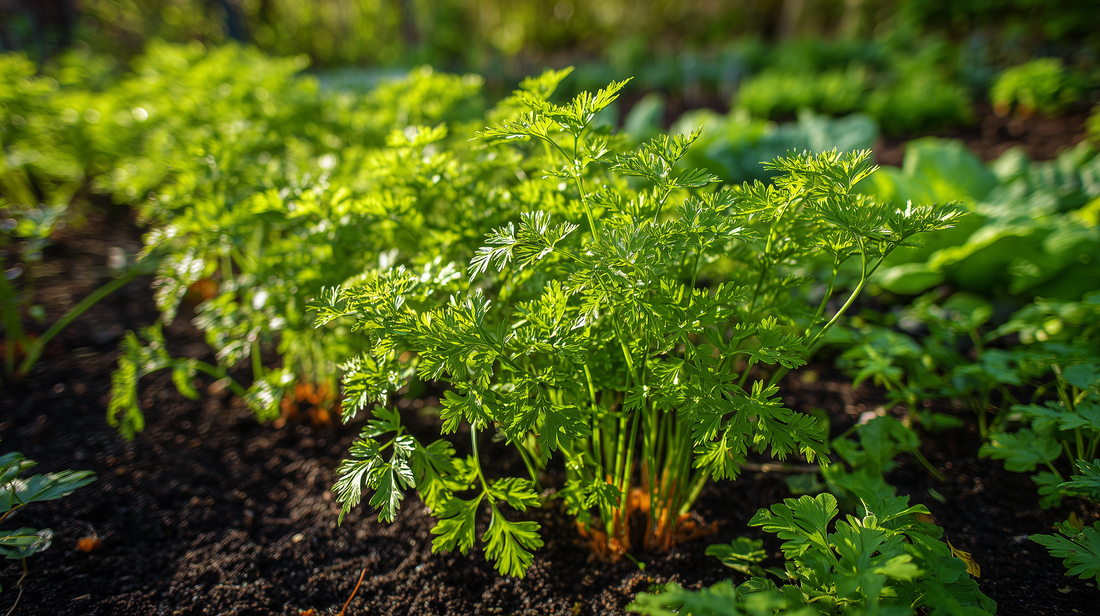CHERVIL
ABOUT THE PLANT
Description: Chervil is a delicate herb with tiny fern-like leaves and tender stems and grows to about 1 foot tall. Its taste is grassy, slightly like parsley, with a somewhat warm anise flavor.
Origin: Chervil is native to Russia, central Asia, and southern Europe
Usage: Chervil is used frequently in French cooking. Combined with parsley, tarragon, and chives, it makes up the "fines herbes ."Use it like you would parsley. Don't cook it; add it at the end of cooking. Sprinkle on meats and fish in soups or as a garnish to salads. Excellent in creamy sauces.
Interesting facts: Chervil is used for fluid retention, cough, digestion problems, and high blood pressure.
HOW TO GROW
General requirements: Plant chervil in rich, well-drained soil with a pH between 6.0 and 6.7. It will thrive in semi-shade and cooler climates. Keep the soil moist but not soggy. Fertilizer is not needed, but side-dress the plants with compost during the growing season. The seeds will germinate better if they receive some light, so do not plant the seeds deep.
In the garden: Sow chervil seed as soon as the soil can be worked in the spring. Plant 1/8 inch deep and 3 inches apart. Lightly sprinkle some fine soil over the seeds and press firmly. They will germinate better with some light. Thin the seedlings to 8-12 inches apart when they are 3 to 4 inches tall. Keep the soil moist but not soggy. For a continual harvest, make a 2nd planting mid-late summer. Sow seeds again in the fall, and they will germinate and grow the following spring.
In containers: Chervil will do great in a container both outdoors and indoors on a windowsill as it does not require full sun. Use a container at least 8 inches deep because chervil has a taproot. Use well-draining potting soil, place a few seeds on the soil's surface, and press down. Sprinkle a dusting of soil over the seeds and keep them moist with gentle misting until germination. Water regularly, do not let the soil dry out, and do not let the soil become soggy.
Transplanting: Sow 4-8 weeks indoors before the last frost in spring. Plant seeds in individual peat containers to avoid disturbing the tap root at transplant time. Use seed starting mix and sow the seeds on the surface, pressing into the soil. Place under fluorescent lights and keep the soil moist at 70 degrees F. After the last frost in spring, plant the entire peat pot in the garden or outdoor containers so as not to disturb the taproot.
HARVESTING
Leaves: You can start harvesting chervil leaves once plants are 6 inches tall or taller. Harvest regularly, treating them as cut and come again. Leaves are best harvested young. Fresh chervil can be stored in the refrigerator for a few days if wrapped in a damp paper towel and sealed in a plastic bag. Alternatively, stand the stems in a container filled with water and keep them on the countertop or in the refrigerator. The leaves will be most flavorful if harvested before the plant blooms.
FAST FACTS
Common name: salad chervil, garden chervil, or French parsley
Latin name: Anthriscus cerefolium
Growth habit: upright branching herb
Life cycle: biennial
USDA Zones: 3-7
Seeds per ounce: about 10,000








